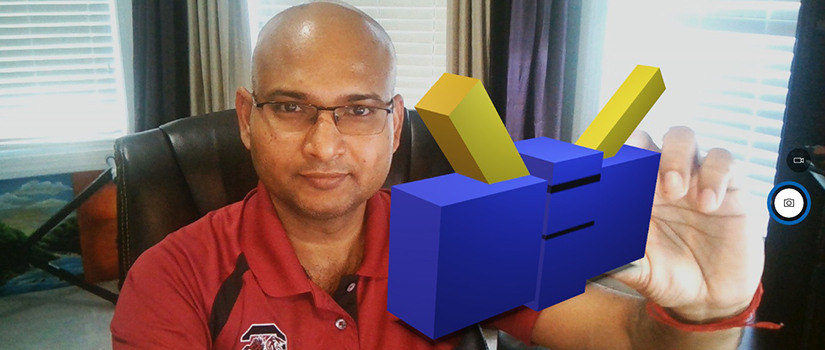By Abe Danaher | April 6, 2020
When the University of South Carolina moved all classes online for the Spring 2020 semester, Sourav Banerjee adapted easily – drawing upon the experience he gained these last few years as he added virtual components to his in-person classes. Now, his focus is on helping his colleagues in the College of Engineering and Computing and the rest of UofSC do the same so that students continue to receive effective instruction.
For the past two weeks, Banerjee has been sharing tutorials with faculty across the college and the university. He created YouTube videos addressing many technological concerns that may be specific to UofSC faculty – problems that he found go largely unaddressed in the broader tutorial segment. And, he has been recommending new software that works for him, in hopes that more faculty adopt Microsoft OneNote, Blackboard Collaborate Ultra, MATLAB, Unity, Mixed Reality with Paint3D and Krita after hearing his own success with the programs.
"What I offer them is critical thinking – how to attack a problem, how to solve. I teach them to start thinking about the solution of the problem. That critical thinking is a virtual thing. It cannot be seen."
-Sourav Banerjee, Mechanical Engineering Associate Professor
Learning to use the technology, he admits, may not be easy. But once faculty members do, he says the results are evident.
“Although we are not meeting with students in-person, there are so many resources available that can give a much, much better experience than in the past,” says Banerjee, an associate professor in the Mechanical Engineering Department. “Of course, not as good as personal contact, but we can add on so many other things that can alleviate some of the issues of not having face-to-face contact.”
Banerjee’s own classroom is a testament to the success that can come through online instruction, even in these difficult times. Brandon Sellers, a student in Banerjee’s mechanics of solids class, went as far as to say that the online learning may benefit students.
Sellers says, “The thing I like most is that Professor Banerjee is able to view questions on the online chat, read the question, and respond quickly instead of having to stop every five minutes or so and ask, ‘does anyone have any questions.’ Which means that students are now able to get their questions sorted out as the class goes, which helps everyone understand better.”
Banerjee says he has been impressed with how his students have responded to the change in teaching style, adding that his introduction to applied numerical methods class of 17 students saw perfect attendance throughout the first week of online class. He adds that the students have been very engaged, which was something that Sellers noticed in his solids class, too.
“Students are asking a lot of questions,” Sellers continued explaining. “They are getting more feedback, which means that they are getting more information that they need to learn the course content.”
Leadership at the university has also taken notice of Banerjee’s success, with President Bob Caslen taking the time to sit through an entire online lecture of his applied numerical methods class.
“I was very impressed with both Dr. Banerjee’s mastery of the curriculum, and how well it was being communicated to his students,” Caslen says. “I was also very pleased to see Blackboard, as the delivery program, well-received by the students. Students were engaged and asking good questions. As with all our faculty, Dr. Banerjee did a great job quickly adapting to a new education delivery method, but still was able to ensure our university accomplished its core mission, and that is to deliver high standard education, with integrity, to our students.”
The reason for this success, Banerjee says, is two-fold. He admits he is lucky to be “ahead of the curve” and already have experience using most of the technology. But, even more so than that, Banerjee’s teaching philosophy of creating critical thinkers lends itself well to online teaching.
“Students can learn anything in Google, but they cannot get what I can provide during my class sessions,” he says. “What I offer them is critical thinking – how to attack a problem, how to solve. I teach them to start thinking about the solution of the problem. That critical thinking is a virtual thing. It cannot be seen. So, it can be delivered virtually through the digital world.”
He knows that not all faculty are as comfortable with online instruction as he is, but he hopes his YouTube videos, tutorials and advice help make their transition online much easier. And he hopes that students remain patient with their instructors, and more than anything, maintain communication with their instructors as if they were still attending class in-person.
“I know from our mechanical department; our faculty are helping even with phone calls,” he says. “I am taking them throughout the day. There are no limits to my office hours. Throughout the day is my office hours, so they can call anytime.”
